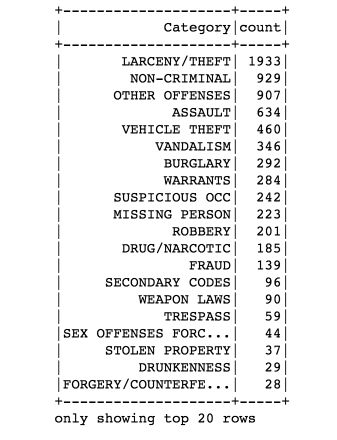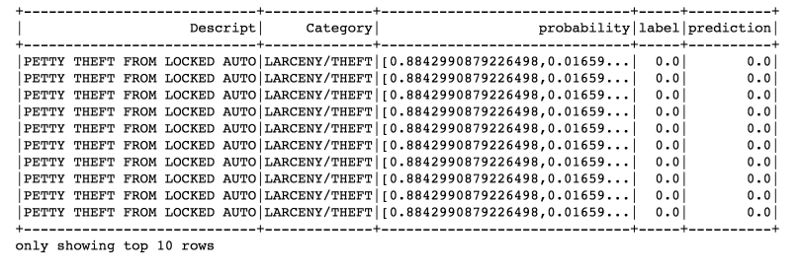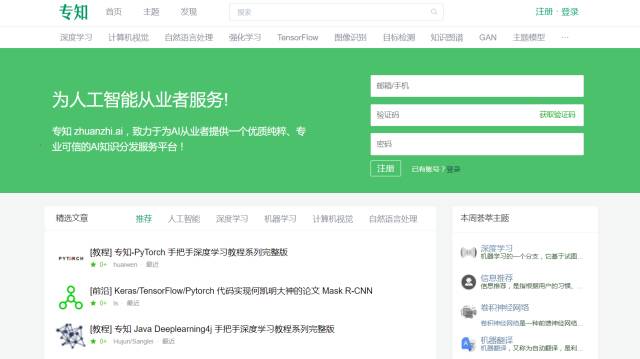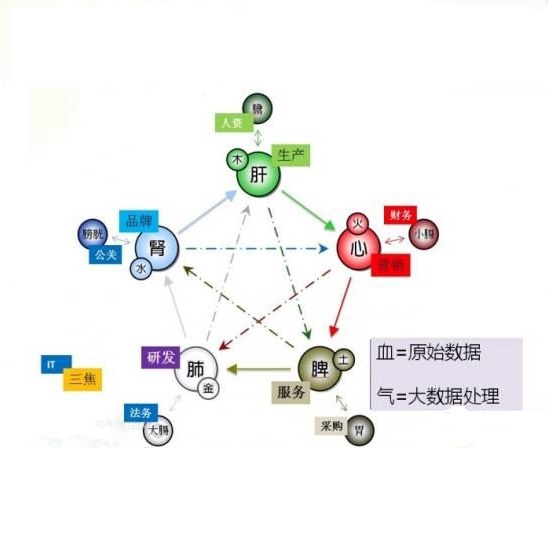【干货】Python大数据处理库PySpark实战——使用PySpark处理文本多分类问题
【导读】近日,多伦多数据科学家Susan Li发表一篇博文,讲解利用PySpark处理文本多分类问题的详情。我们知道,Apache Spark在处理实时数据方面的能力非常出色,目前也在工业界广泛使用。本文通过使用Spark Machine Learning Library和PySpark来解决一个文本多分类问题,内容包括:数据提取、Model Pipeline、训练/测试数据集划分、模型训练和评价等,具体细节可以参考下面全文。
Multi-Class Text Classification with PySpark
Apache Spark受到越来越多的关注,主要是因为它处理实时数据的能力。每天都有大量的数据需要被处理,如何实时地分析这些数据变得极其重要。另外,Apache Spark可以再不采样的情况下快速处理大量的数据。许多工业界的专家提供了理由: why you should use Spark for Machine Learning?[1]
现在我们来用Spark Machine Learning Library[2]和PySpark来解决一个文本多分类问题。
如果你想看一个scikit-learn版本的实现,可以读上一篇文章: previous article[3]。
数据
我们的任务,是将旧金山犯罪记录(San Francisco Crime Description)分类到33个类目中。数据可以从Kaggle中下载:
https://www.kaggle.com/c/sf-crime/data。
给定一个犯罪描述,我们想知道它属于33类犯罪中的哪一类。分类器假设每个犯罪一定属于且仅属于33类中的一类。这是一个多分类的问题。
输入:犯罪描述。例如:“ STOLEN AUTOMOBILE”
输出:类别。例如:VEHICLE THEFT
为了解决这个问题,我们在Spark的有监督学习算法中用了一些特征提取技术。
数据提取
利用Spark的csv库直接载入CSV格式的数据:
from pyspark.sql import SQLContext
from pyspark import SparkContext
sc =SparkContext()
sqlContext = SQLContext(sc)
data = sqlContext.read.format('com.databricks.spark.csv').options(header='true',
inferschema='true').load('train.csv')
除去一些不要的列,并展示前五行:
drop_list = ['Dates', 'DayOfWeek', 'PdDistrict', 'Resolution', 'Address', 'X', 'Y']
data = data.select([column for column in data.columns if column not in drop_list])
data.show(5)
利用printSchema()方法来显示数据的结构:
data.printSchema()
包含数量最多的20类犯罪:
from pyspark.sql.functions import col
data.groupBy("Category") \
.count() \
.orderBy(col("count").desc()) \
.show()
包含犯罪数量最多的20个描述:
data.groupBy("Descript") \
.count() \
.orderBy(col("count").desc()) \
.show()
流水线(Model Pipeline)
我们的流程和scikit-learn版本的很相似,包含3个步骤:
1. regexTokenizer:利用正则切分单词
2. stopwordsRemover:移除停用词
3. countVectors:构建词频向量
from pyspark.ml.feature import RegexTokenizer, StopWordsRemover, CountVectorizer
from pyspark.ml.classification import LogisticRegression
# regular expression tokenizer
regexTokenizer = RegexTokenizer(inputCol="Descript", outputCol="words", pattern="\\W")
# stop words
add_stopwords = ["http","https","amp","rt","t","c","the"]
stopwordsRemover = StopWordsRemover(inputCol="words", outputCol="filtered").
setStopWords(add_stopwords)
# bag of words count
countVectors = CountVectorizer(inputCol="filtered", outputCol="features",
vocabSize=10000, minDF=5)
StringIndexer
StringIndexer将一列字符串label编码为一列索引号(从0到label种类数-1),根据label出现的频率排序,最频繁出现的label的index为0。
在该例子中,label会被编码成从0到32的整数,最频繁的 label(LARCENY/THEFT) 会被编码成0。
from pyspark.ml import Pipeline
from pyspark.ml.feature import OneHotEncoder, StringIndexer, VectorAssembler
label_stringIdx = StringIndexer(inputCol = "Category", outputCol = "label")
pipeline = Pipeline(stages=[regexTokenizer, stopwordsRemover, countVectors,
label_stringIdx])
# Fit the pipeline to training documents.
pipelineFit = pipeline.fit(data)
dataset = pipelineFit.transform(data)
dataset.show(5)
训练/测试数据集划分
# set seed for reproducibility
(trainingData, testData) = dataset.randomSplit([0.7, 0.3], seed = 100)
print("Training Dataset Count: " + str(trainingData.count()))
print("Test Dataset Count: " + str(testData.count()))
训练数据量:5185
测试数据量:2104
模型训练和评价
1.以词频作为特征,利用逻辑回归进行分类
我们的模型在测试集上预测和打分,查看10个预测概率值最高的结果:
lr = LogisticRegression(maxIter=20, regParam=0.3, elasticNetParam=0)
lrModel = lr.fit(trainingData)
predictions = lrModel.transform(testData)
predictions.filter(predictions['prediction'] == 0) \
.select("Descript","Category","probability","label","prediction") \
.orderBy("probability", ascending=False) \
.show(n = 10, truncate = 30)
from pyspark.ml.evaluation import MulticlassClassificationEvaluator
evaluator = MulticlassClassificationEvaluator(predictionCol="prediction")
evaluator.evaluate(predictions)
准确率是0.9610787444388802,非常不错!
2.以TF-IDF作为特征,利用逻辑回归进行分类
from pyspark.ml.feature import HashingTF, IDF
hashingTF = HashingTF(inputCol="filtered", outputCol="rawFeatures", numFeatures=10000)
idf = IDF(inputCol="rawFeatures", outputCol="features", minDocFreq=5)
#minDocFreq: remove sparse terms
pipeline = Pipeline(stages=[regexTokenizer, stopwordsRemover, hashingTF, idf,
label_stringIdx])
pipelineFit = pipeline.fit(data)
dataset = pipelineFit.transform(data)
(trainingData, testData) = dataset.randomSplit([0.7, 0.3], seed = 100)
lr = LogisticRegression(maxIter=20, regParam=0.3, elasticNetParam=0)
lrModel = lr.fit(trainingData)
predictions = lrModel.transform(testData)
predictions.filter(predictions['prediction'] == 0) \
.select("Descript","Category","probability","label","prediction") \
.orderBy("probability", ascending=False) \
.show(n = 10, truncate = 30)
evaluator = MulticlassClassificationEvaluator(predictionCol="prediction")
evaluator.evaluate(predictions)
准确率是0.9616202660247297,和上面结果差不多。
3.交叉验证
用交叉验证来优化参数,这里我们针对基于词频特征的逻辑回归模型进行优化。
pipeline = Pipeline(stages=[regexTokenizer, stopwordsRemover, countVectors, label_stringIdx])
pipelineFit = pipeline.fit(data)
dataset = pipelineFit.transform(data)
(trainingData, testData) = dataset.randomSplit([0.7, 0.3], seed = 100)
lr = LogisticRegression(maxIter=20, regParam=0.3, elasticNetParam=0)
from pyspark.ml.tuning import ParamGridBuilder, CrossValidator
# Create ParamGrid for Cross Validation
paramGrid = (ParamGridBuilder()
.addGrid(lr.regParam, [0.1, 0.3, 0.5]) # regularization parameter
.addGrid(lr.elasticNetParam, [0.0, 0.1, 0.2])
# Elastic Net Parameter (Ridge = 0)
# .addGrid(model.maxIter, [10, 20, 50]) #Number of iterations
# .addGrid(idf.numFeatures, [10, 100, 1000]) # Number of features
.build())
# Create 5-fold CrossValidator
cv = CrossValidator(estimator=lr, \
estimatorParamMaps=paramGrid, \
evaluator=evaluator, \
numFolds=5)
cvModel = cv.fit(trainingData)
predictions = cvModel.transform(testData)
# Evaluate best model
evaluator = MulticlassClassificationEvaluator(predictionCol="prediction")
evaluator.evaluate(predictions)
准确率变成了0.9851796929217101,获得了提升。
4.朴素贝叶斯
from pyspark.ml.classification import NaiveBayes
nb = NaiveBayes(smoothing=1)
model = nb.fit(trainingData)
predictions = model.transform(testData)
predictions.filter(predictions['prediction'] == 0) \
.select("Descript","Category","probability","label","prediction") \
.orderBy("probability", ascending=False) \
.show(n = 10, truncate = 30)
evaluator = MulticlassClassificationEvaluator(predictionCol="prediction")
evaluator.evaluate(predictions)
准确率:0.9625414629888848
4.随机森林
from pyspark.ml.classification import RandomForestClassifier
rf = RandomForestClassifier(labelCol="label", \
featuresCol="features", \
numTrees = 100, \
maxDepth = 4, \
maxBins = 32)
# Train model with Training Data
rfModel = rf.fit(trainingData)
predictions = rfModel.transform(testData)
predictions.filter(predictions['prediction'] == 0) \
.select("Descript","Category","probability","label","prediction") \
.orderBy("probability", ascending=False) \
.show(n = 10, truncate = 30)
evaluator = MulticlassClassificationEvaluator(predictionCol="prediction")
evaluator.evaluate(predictions)
准确率:0.6600326922344301
上面结果可以看出:随机森林是优秀的、鲁棒的通用的模型,但是对于高维稀疏数据来说,它并不是一个很好的选择。
明显,我们会选择使用了交叉验证的逻辑回归。
代码在Github上:https://github.com/susanli2016/Machine-Learning-with-Python/blob/master/SF_Crime_Text_Classification_PySpark.ipynb。
参考文献:
[1] https://www.infoworld.com/article/3031690/analytics/why-you-should-use-spark-for-machine-learning.html
[2] https://spark.apache.org/docs/1.1.0/mllib-guide.html
[3] https://towardsdatascience.com/multi-class-text-classification-with-scikit-learn-12f1e60e0a9f
原文链接:
https://towardsdatascience.com/interpretability-in-machine-learning-70c30694a05f
-END-
专 · 知
人工智能领域主题知识资料查看获取:【专知荟萃】人工智能领域26个主题知识资料全集(入门/进阶/论文/综述/视频/专家等)
请PC登录www.zhuanzhi.ai或者点击阅读原文,注册登录专知,获取更多AI知识资料!
请扫一扫如下二维码关注我们的公众号,获取人工智能的专业知识!
请加专知小助手微信(Rancho_Fang),加入专知主题人工智能群交流!
点击“阅读原文”,使用专知
















